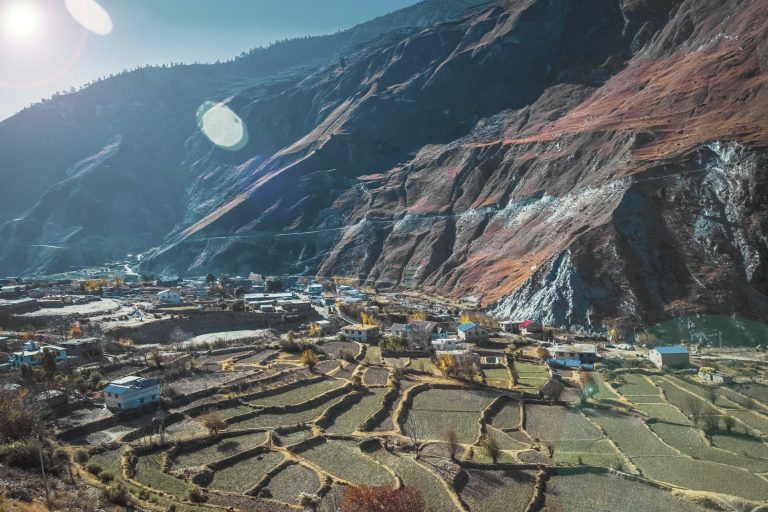
Climate change research, capacity building and communication on climate extremes over South Asia
Keywords
Capacity building · Climate change · Climate extremes · Science-to-policy communication · South Asia
HIGHLIGHTS
- Generated reliable 5 km reference climate data for Bangladesh, Nepal and Pakistan.
- Selected the best climate models for Coupled Model Intercomparison Project Phase 6 (CMIP6) for Bangladesh, Nepal and Pakistan.
- Downscaled CMIP6 models over Bangladesh, Nepal and Pakistan under different Shared Socioeconomic Pathways (SSPs).
- Capacity building through workshops, training sessions and university courses to empower researchers and students, focusing on promoting female involvement and supporting early career researchers.
- Communicated scientific findings to policymakers, stakeholders and the public through diverse channels, e.g., media.
1. INTRODUCTION
Climate extremes, such as heatwaves, floods, droughts and storms, have become increasingly frequent and severe in recent years, posing significant challenges to human societies, economies and ecosystems (Intergovernmental Panel on Climate Change [IPCC], 2023). These extreme weather events can result in loss of lives, health problems, damage to infrastructure, disruption of essential services, displacement and loss of livelihoods, particularly in vulnerable regions such as South Asia. Understanding the changing patterns and impacts of climate extremes at local scales is crucial for developing effective adaptation plans and reducing vulnerability to these events (Ali et al., 2019; Kundzewicz et al., 2019; Pörtner et al., 2022). The South Asian region has already been experiencing extreme events in recent decades, like floods, heat waves, heavy rainfall, among others. Studies show that the extreme phenomena will change in the future. For instance, Khan et al. (2023) and Ali et al. (2019) suggested that the cold days are decreasing while the warm nights will increase in Pakistan. These studies further suggested that the consecutive wet days (CWD) and consecutive dry days (CDD) will decrease and increase in the future, respectively, under both climate change Representative Concentration Pathways (RCP4.5 and 8.5) over Pakistan. A recent study based on observed data claimed that summer days (SU25) increased during 1991–2019 compared to 1962–1990 in Pakistan (Khan et al., 2022). A study about temperature and rainfall extremes in Bangladesh claimed that the warming has increased. However, the coastal areas have shown a higher rate of warming over the last five decades (Abdullah et al., 2022). A study investigated the trends of climate extremes in Bangladesh and concluded that mean monsoon seasonal rainfall can alter, posing significant challenges to agriculture, hydropower and the ecosystem (Rimi et al., 2022). Nepal has experienced extreme events due to climate extremes in recent decades. Studies claimed that heavy and extreme rainfall will increase under the RCP4.5 and RCP8.5 over Nepal (Chapagain et al., 2021; Pandey & Mishra, 2022). Hence, the importance of research in elucidating the changing patterns and impacts of climate extremes in South Asia cannot be overstated. Robust scientific methodologies, data collection and analysis are essential for generating reliable evidence to inform policymakers and stakeholders in developing effective adaptation and mitigation strategies (Karmakar et al., 2020). Furthermore, capacity-building efforts are critical to enhancing the capabilities of local researchers, institutions and communities in conducting climate change research. This includes training programs, workshops and knowledge-sharing platforms to foster multidisciplinary collaboration, promote scientific literacy and facilitate policy-relevant research (Mbah et al., 2022).
The project “Towards Robust Projections of Climate Extremes and Adaptation Plans over South Asia” addressed this need for high-resolution data on climate extremes in South Asia. The project brought together an interdisciplinary team of researchers from various institutions in South Asia and beyond and utilised state-of-the-art climate modelling techniques, data analysis and stakeholder engagement to achieve its objectives. The study’s primary objectives include preparing high-resolution reference and future model data for climate extremes in South Asia, including minimum and maximum temperature and precipitation at 5 km resolution. The validation of Global Climate Models (GCMs) involved in CMIP6 was carried out over the study area, and then GCMs were downscaled to regional and local scales using advanced statistical downscaling techniques. The resulting high-resolution data sets provide a valuable resource for researchers, policymakers and other stakeholders to understand better the current and future trends of climate extremes in South Asia (Ali & Reboita, 2022).
In addition, capacity building and effective communication of climate change research findings and policy recommendations are crucial for creating awareness, influencing policy decisions and fostering public engagement. Science communication efforts that involve various stakeholders, including policymakers, researchers, communities, media and civil society organisations, play a vital role in translating complex scientific information into accessible formats for different audiences (Nisbet, 2018). Clear, accurate and timely communication of climate change research findings is essential for promoting evidence-based decision-making and fostering resilience (Kiani & Kiyani, 2023). The project also emphasised effective communication of climate change research findings and policy recommendations using diverse channels and formats, such as reports, publications, multimedia and social media. A small grant project of APN, which communicated the scientific outputs of the project in a simple way, is outlined in Kiani & Kiyani (2023).
Overall, the project “Towards Robust Projections of Climate Extremes and Adaptation Plans over South Asia,” funded by the Asia-Pacific Network for Global Change Research (APN) (CRRP2018-04MY-Ali), has significantly contributed to enhancing our understanding of climate extremes in the region. It provided high-resolution reference and historical future model data, strengthened research capacities and promoted effective science communication. This paper highlights the actions and achievements during the project’s execution and information on the project can be accessed at https://doi.org/10.30852/p.4583.
2. METHODOLOGY
2.1. Study area
The study area encompasses three South Asian countries: Bangladesh, Nepaland Pakistan. These countries are geographically diverse, ranging from the fertile river plains of Bangladesh to the high Himalayan mountains of Nepal and the vast arid regions of Pakistan. Climatology in this region is of great significance due to its impact on agriculture, water resources, natural disasters and the overall socioeconomic development of the population. Bangladesh experiences a tropical monsoon climate with high temperatures, heavy rainfall and high humidity (Ali et al., 2023). Bangladesh is vulnerable to climate change due to its low-lying coastal areas. Rising sea levels, increased frequency of cyclones and changes in precipitation patterns pose significant challenges. The country experiences droughts and floods, impacting agriculture, water availability and human settlements. Nepal is highly susceptible to climate change impacts, including glacial melt, altered precipitation patterns and increased frequency of extreme events (Maharjan et al., 2023; Pokharel et al., 2019). Changes in the Himalayan glaciers affect water resources, agriculture and hydropower generation. Pakistan faces various climate challenges, including water scarcity, heatwaves, droughts and floods. The country’s agricultural productivity heavily depends on water availability from rivers fed by melting glaciers in the Himalayas.
Understanding climate variability and change in these three countries is crucial for effective adaptation and mitigation strategies. The study area is shown in Figure 1.
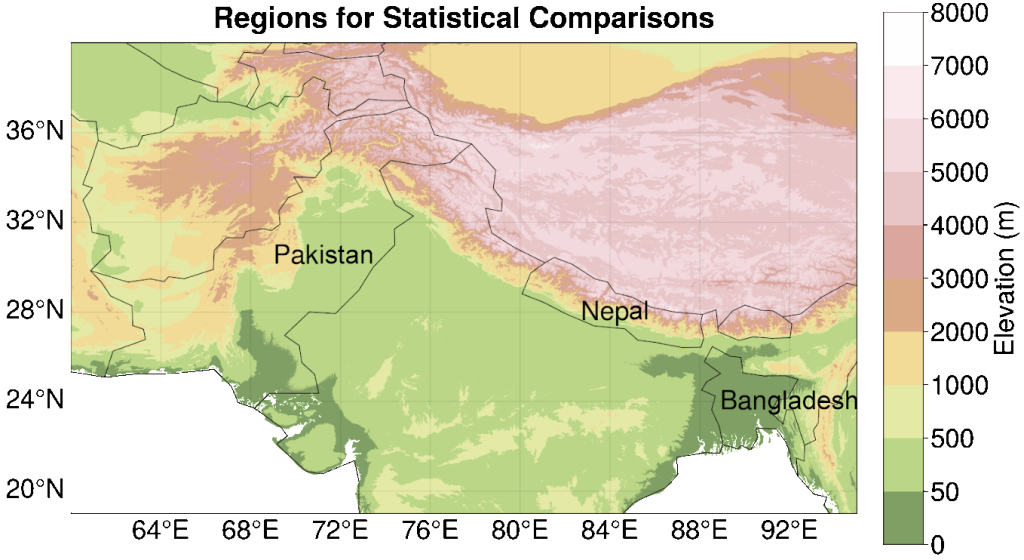
2.2. Method
The methodology is divided into three parts: (1) Climate Science, (2) Capacity Building and (3) Communication. Details for each of these parts are outlined below:
2.2.1. Climate science
In the climate science aspect, the methodology involves three steps: firstly, the preparation of 5 km reference data; secondly, the validation of CMIP6 models over Pakistan, Bangladesh and Nepal; and thirdly, the downscaling of CMIP6 data at 5 km and future projection. Details are below:
- 5 km data results Objective and subjective techniques were used to perform quality control on the observed station data (Ali et al., 2023) from 1981 to 2016. The observed data are merged with ERA5 and a higher weight is given to station data during spatial interpolation to 5 km with the Kriging method. For temperature, an additional step was performed: the interpolated data were adjusted using the average Lapse Rate of Temperature (LRT) in mountainous regions using data from the Global 30 Arc-Second Elevation (GTOPO30) provided by the U.S. Geological Survey (USGS).
- Validation From CMIP6 (https://esgf-node.llnl.gov/search/cmip6/), we obtained temperature and precipitation data of 48 GCMs for the historical period. The data from GCMs were compared to a novel gridded dataset created in the first step using meteorological station observations for 1994–2014. Three ranking methods were employed for analysis to determine the best models: (1) individual representation of precipitation and air temperature for each country, (2) separate representation of precipitation and air temperature encompassing all three countries and (3) combined representation of both precipitation and air temperature across all three countries.
- Downscaling and Future projection We statistically downscaled/bias-corrected the CMIP6 selected models using spatial disaggregation quantile delta mapping (SDQDM) from 2020 to 2100. This method overcomes the stationarity problem in data and preserves the trend in future climate signals (Ali et al., 2019).
2.2.2. Capacity building
The project embarked on a comprehensive capacity-building endeavour encompassing various components, including training workshops, lectures, university courses and internships, emphasizing achieving gender balance by actively involving 60% female participants. We also delivered a six-month university course to enhance the capacity of female researchers from South Asia in the field of meteorology. Furthermore, a series of workshops was conducted in China, Pakistan and Nepal. University lectures and participation aim to introduce climate studies concepts to aspiring students. Moreover, the capacity-building initiative extended its reach to the general public through interviews, news coverage and newspaper articles that shed light on the research and its consequential impacts, garnering positive feedback from diverse quarters. A dedicated media training workshop focusing on extreme weather events engaged media organisations and professionals from the health sector, facilitating the widespread dissemination of critical information. The project also provided guidance and supervision to four students as they prepared their university degree theses, enabling them to delve deeper into climate science, climate modelling and data analysis. This internship experience equipped them with essential management skills and paved the way for new opportunities in their future pursuits.
2.2.3. Science to policy communication
A diverse range of communication channels were utilised for communicating scientific discoveries proficiently to policymakers and the broader public. This comprehensive strategy involved electronic and print media, workshops and technical and policy reports. Information derived from our research was disseminated across diverse platforms, including electronic and print media, to bridge the gap between science and policy. Multiple interviews on national channels, conducted in local and national languages, facilitated the spread of climate change awareness, reaching grassroots communities. Additionally, headline news stories and written newspaper articles played a foundational role, educating youth and students and acquainting the general public with these complex concepts. Numerous lectures delivered at universities and participation in international and national workshops and media training programs served as effective avenues for widespread knowledge dissemination. Furthermore, reports and publications were provided to the Ministry of Climate Change and research articles and papers were made available online with open access, further reducing barriers to access.
3. RESULTS AND DISCUSSION
3.1. Climate science
3.1.1. 5-km data results
The study successfully generated high-resolution reference data of 5 km for Pakistan, Nepal and Bangladesh, which provided a reliable and accurate basis for analysing the climate in the region. Figure 2 shows the climatology of precipitation, minimum, mean and maximum temperature over Pakistan, Nepal and Bangladesh using 5 km datasets. Precipitation is highest during the monsoon season and lowest in December to February (DJF). Nepal and Bangladesh receive more rain than Pakistan due to humidity transported by stronger winds (near to sea) and topography effect. Precipitation also exerts an influence on temperature. Pakistan is the warmest country due to less precipitation, while Nepal and Bangladesh have moderate temperatures due to more precipitation. Due to latitude and altitude influences, Pakistan and Nepal’s northern parts (NP) show lower temperatures. The annual cycle of mean temperature indicates that NP is the coldest region, while the middle southern is the hottest in Pakistan and Nepal. The increase in temperature due to climate change is observed in all three countries, with the highest increase in Nepal and the lowest in Bangladesh. The temperature rise varies in different regions of Pakistan. Annual precipitation decreases in some regions of all three countries and the seasonal monsoon precipitation from June–July–August increases in Pakistan but decreases in Bangladesh and western Nepal.
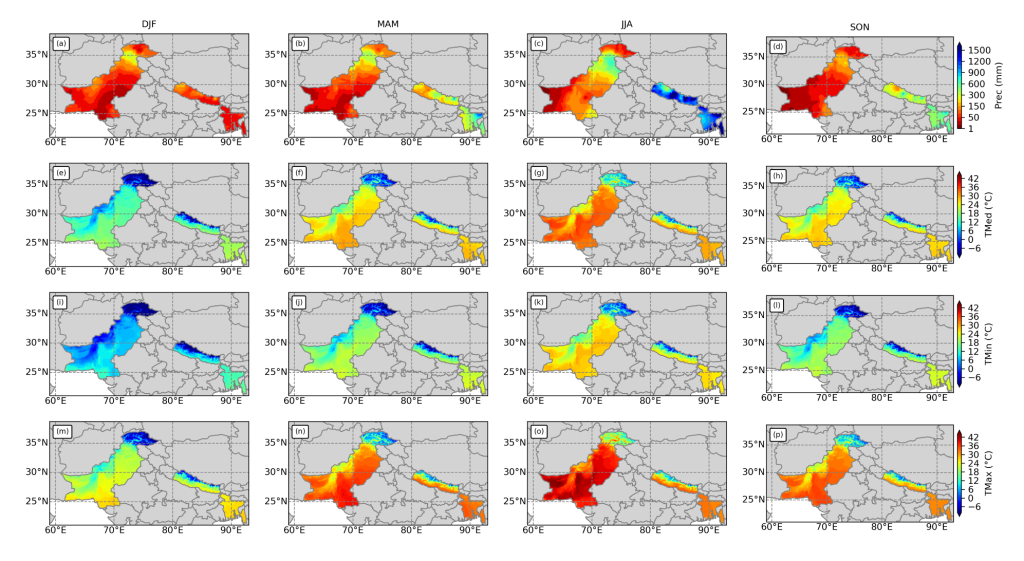
3.1.2. Validation
A range of metrics were applied to elucidate the strengths and weaknesses of CMIP6 models. The results show that NorESM2-MM, AWI-CM-1-1-MR, GISS-E2-1-G, GISS-E2-1-H, CMCC-CM2-SR5and KACE-1-0-G were some of the best CMIP6 models for precipitation and air temperature in the individual countries. The results also suggested that IITM-ESM, EC-Earth3-AerChemand EC-Earth3-Veg are the best models for the overall region and variables. These selected models can be used for climate change assessments, impact studies and regional policymaking. Figure 3 presents the validation results.
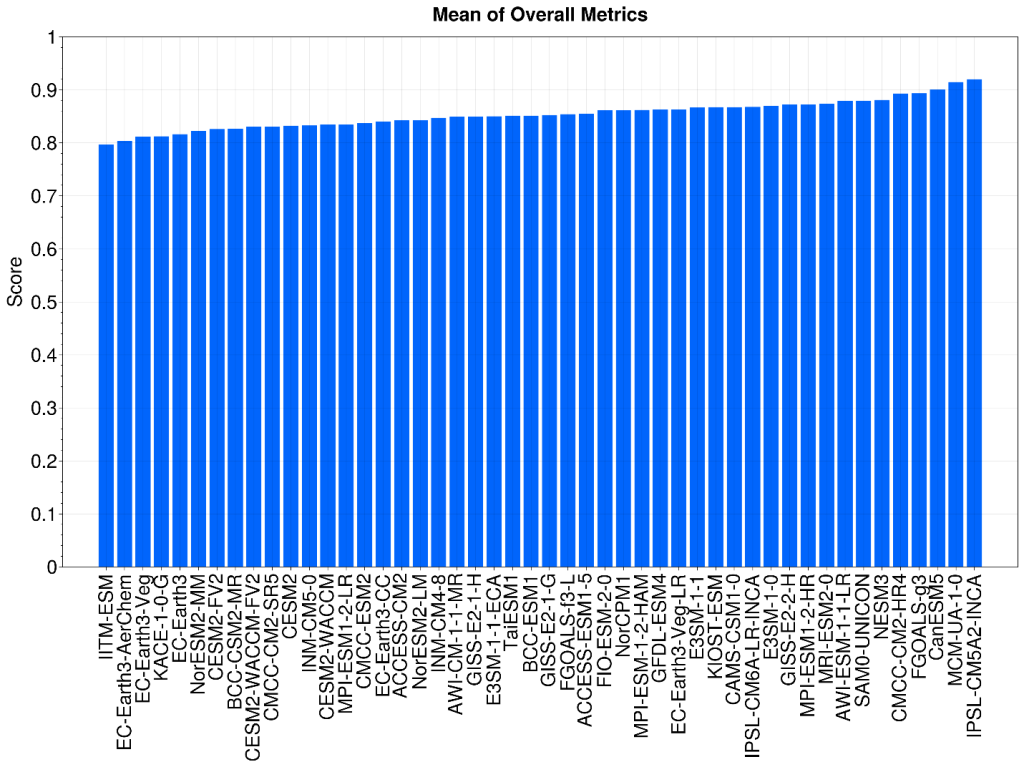
3.1.3. Downscaling and Future projection
The generated high-resolution reference data were then used to downscale the CMIP6 selected models. The projections were developed for different greenhouse gas emission scenarios, SSPs to capture a range of potential future climate conditions. One example of Nepal’s future precipitation projection with SSP2-4.5 is shown in Figure 4 and SSP5-8.5 in Figure 5.
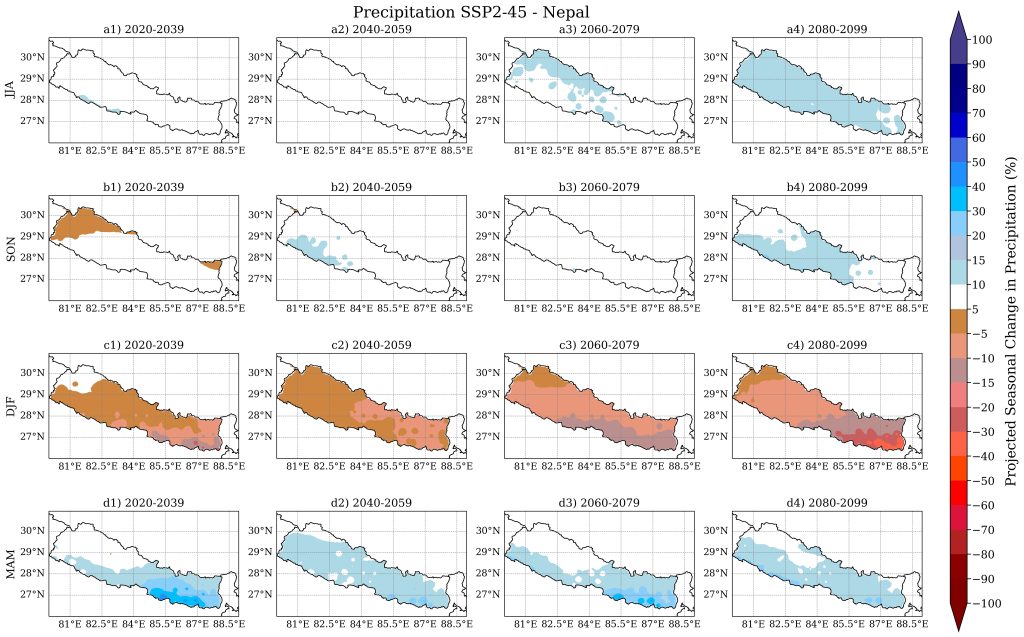
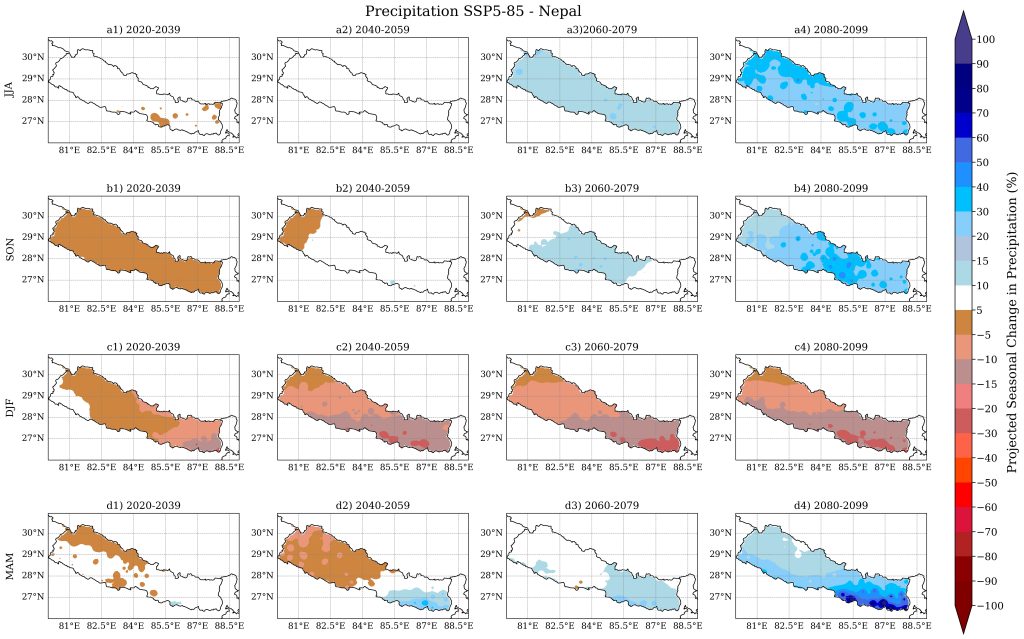
The climate science of the project has published eight research papers in peer-reviewed journals, covering various topics such as spatial monsoon shifts, climate extremes and the impact of climate change on health. These papers have significantly contributed to our understanding of future climate extremes in South Asia and added to the global scientific knowledge on climate change and its impacts. Two of these research papers were cited in the recent Sixth Assessment Report (AR6) by the IPCC, indicating the significance and relevance of the project’s findings for global climate change assessments. Furthermore, the high-resolution reference data and future models produced by the project have been valuable sources of information for impact adaptation and vulnerability studies in the region. The monthly mean of reference data is available (Ali & Reboita, 2022).
3.2. Capacity building
The study also conducted capacity-building activities to enhance the research capabilities of local researchers and students. This included workshops, training sessions and complete university courses conducted in China, Pakistan and Nepal, which provided hands-on training in climate change modelling, data analysis techniques and downscaling methods. These capacity-building efforts aimed to strengthen the skills and knowledge of local researchers in climate change research and facilitate their active participation in the project. During these activities, 200 students were trained.
Ten lectures were delivered at conferences and workshops in Pakistan, as well as two international presentations at conferences in Malaysia and Austria, which helped disseminate knowledge and raise awareness among local and international stakeholders.
The online courses on atmospheric science and climate modelling titled “Introduction to Atmospheric Science: A Look into the Southern and Northern Hemispheres” and “Climate Modelling and Data Analysis” were launched in 2022 for female students in Pakistan in collaboration with the Universidade Federal de Itajubá (UNIFEI), Brazil. The course has been conducted again this year, with students from Nepal and Bangladesh participating to promote regional and international collaboration and cultural exchange. The course aims to build the capacity of female students and early-career female researchers in the three countries, promoting women’s empowerment and gender balance. In the first semester of 2022, 30 Pakistani students were taught the basics of climate science and climate models, while in the first semester of 2023, 30 students from Nepal, Bangladesh and Pakistan combined were taught the technicalities of basic climate science. These efforts collectively contributed to bridging the divide between scientific research and policy communication. The research papers generated vital information that will significantly inform evidence-based policymaking in the field of climate science within the country.
3.3. Science to policy communication & research collaboration
Effective communication of the scientific outputs was emphasised, utilising various channels and formats, such as television, radio, newspapers, workshops and awareness events, to disseminate the research findings to policymakers, stakeholders and the public. Clear and accessible communication of complex scientific information was emphasised to raise awareness about climate extremes and their impacts in the study area and to inform evidence-based decision-making processes.
Five news articles were published. The articles explained the country’s vulnerability in terms of future hotspot cities, possible changes in monsoon over the region of Pakistan, climate change and health and discussed the policy implications of the research. Five television interviews and two radio programmes were conducted in different local languages, including English, to promote research under the project.
The project collaborated with national and international organisations to enhance research and collaboration in South Asia (Bangladesh, Nepal and Pakistan). This involved partnerships with local research institutions, government agencies and international organisations to share data, expertise and resources. The collaboration aimed to foster multidisciplinary research, promote knowledge exchange and enhance the relevance and applicability of the project’s findings for policy and decision-making processes.
4. CONCLUSION
The study of future climate extremes at small scales with robustness depends on high-resolution reference and model data. The statistical and dynamical downscaling communities aim to improve reference and model data to produce reliable data at the local level, reduce uncertainty and establish policymakers’ confidence in future climate extremes. However, there are gaps in finer resolution, scaling issues between reference and model data and insufficient observation data in South Asia. High-resolution regional/local future climate extremes information is urgent for impact adaptation and vulnerability studies. To address this need, the project “Towards robust projections of climate extremes and adaptation plans over South Asia” was undertaken to produce 5 km reference data over Pakistan, Nepal and Bangladesh and fine-resolution climate model data for the future projection of extreme events. These higher-resolution data allowed for the projection of climate extremes in the region. Scientific research conducted under the project has led to the publication of eight research papers in well-reputed impact factor journals, with two cited in the recent AR6 report.
In addition to data preparation, the project has organised significant capacity building activities. Workshops were held in China, Pakistan and Nepal to train young researchers and students in climate change modelling, climate change and media and climate change and health. These workshops were attended by experts from around the world, with technical experts from Brazil and a collaborator from Bangladesh present physically. Gender equality was ensured in the workshops and over 200 students were trained. The workshops received much appreciation and were highlighted in local media channels.
This project employed a variety of media channels to communicate its outcomes to policymakers. Five news articles were published in English newspapers, two radio interviews were conducted and five television interviews were held. Furthermore, the project’s findings were presented at ten national and two international conferences. Throughout the project, collaboration was established with several national and international organisations, highlighting APN’s crucial role in advancing regional research and cooperation.
Overall, this project has significantly contributed to understanding future climate extremes in South Asia, provided high-resolution data for impact adaptation and vulnerability studies and organised capacity-building activities to train young researchers and students. Communicating the project’s outcomes to policymakers through multiple media channels and collaboration with national and international organisations further highlights its importance in promoting regional research and collaboration.
5. ACKNOWLEDGEMENT
This article is based on work supported by the Asia-Pacific Network for Global Change Research (APN) under Grant No. CRRP2018-04MY-Ali. We also thank the APN Secretariat, especially Dr Nafesa Ismail and Dr Linda Anne Stevenson, for their invaluable support. We are also grateful to GCISC, Small Earth Nepal and the Institute of Atmospheric Physics, CAS, Beijing, for providing logistics for various activities, including organising workshops.